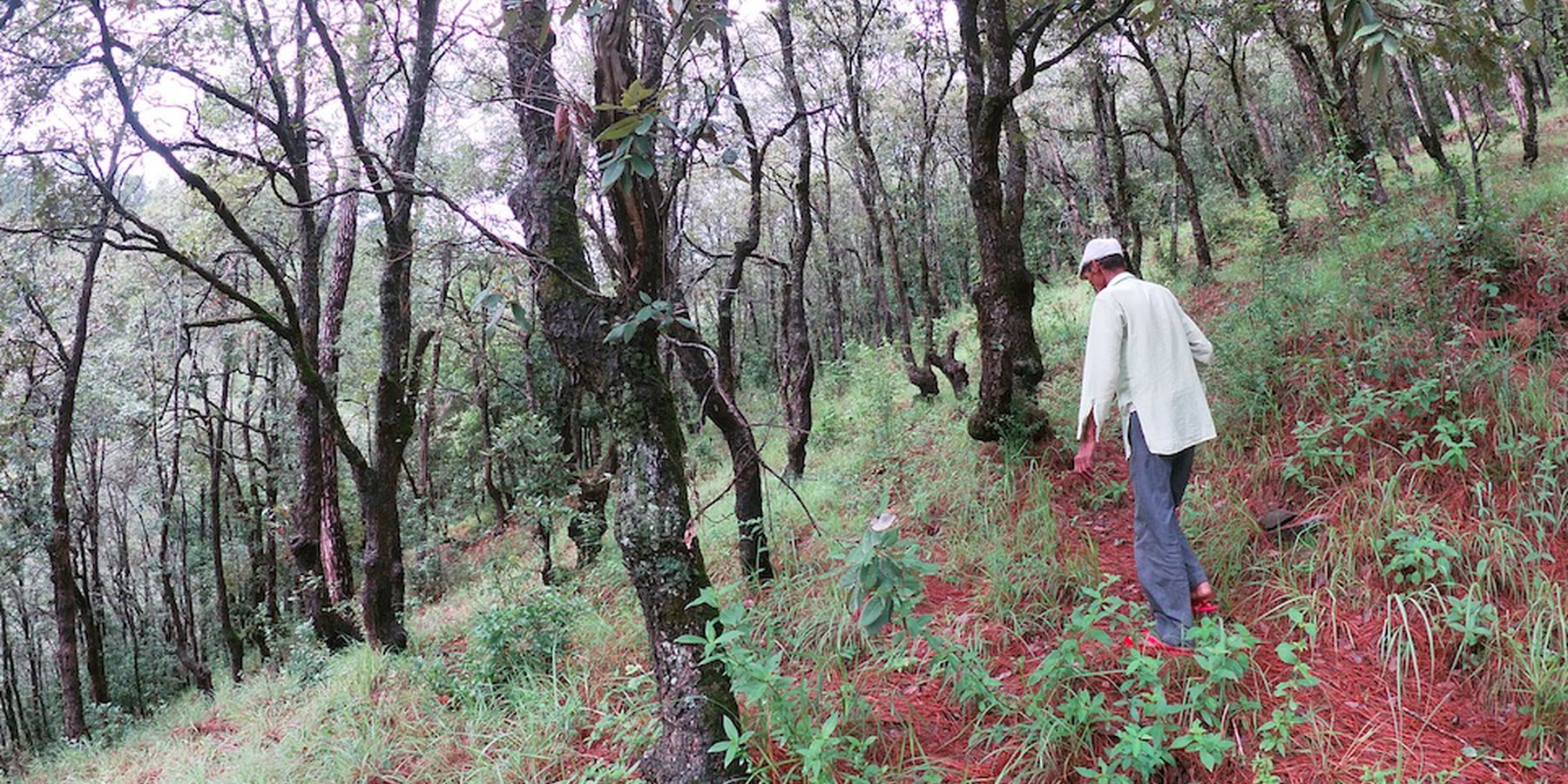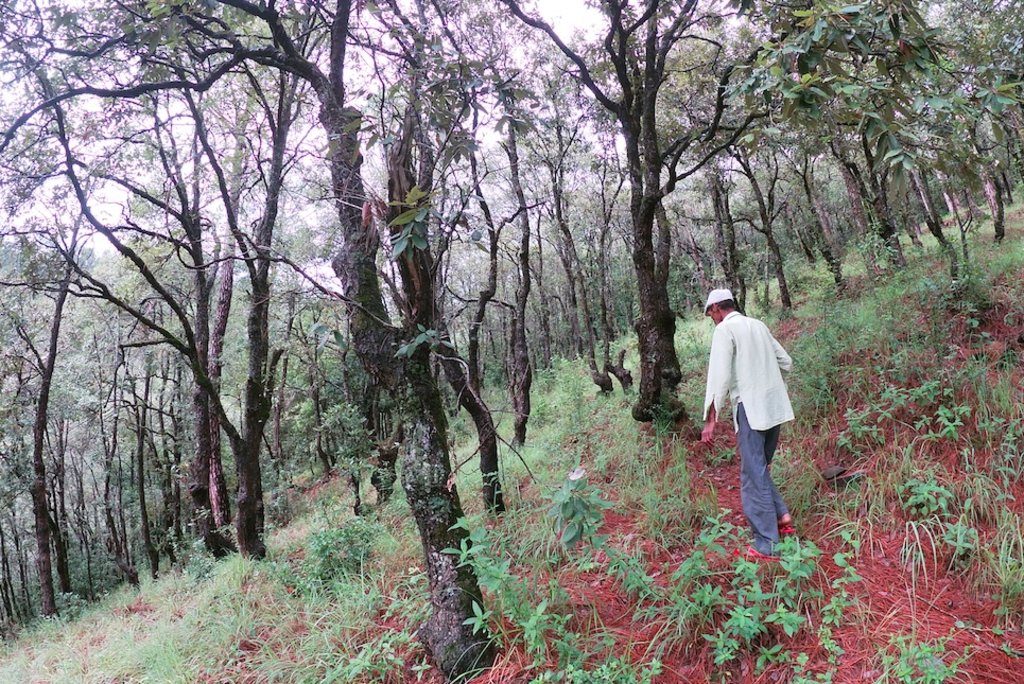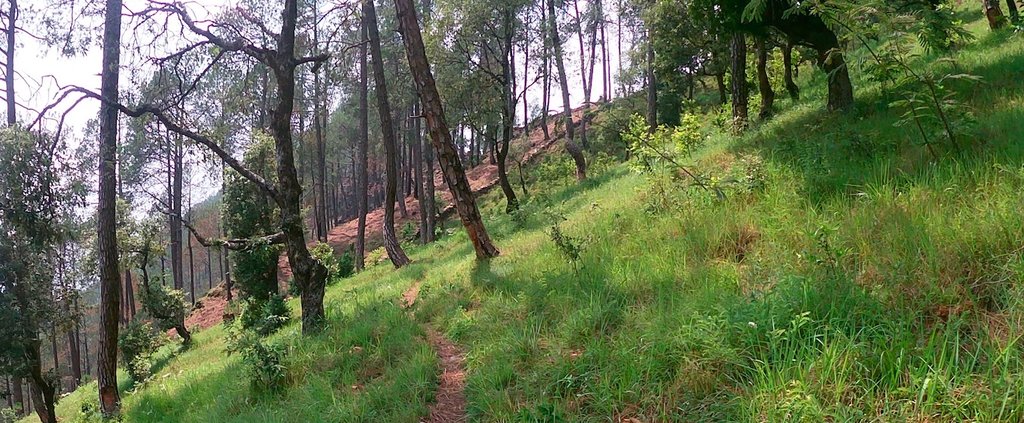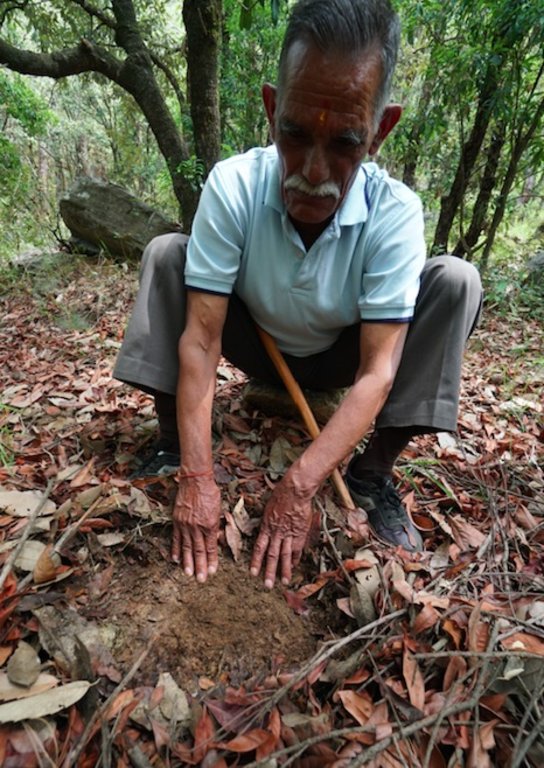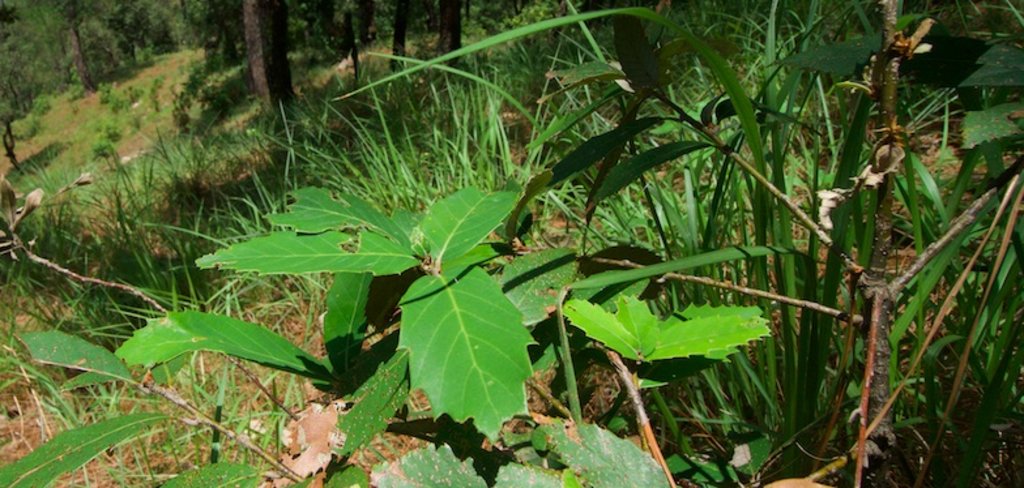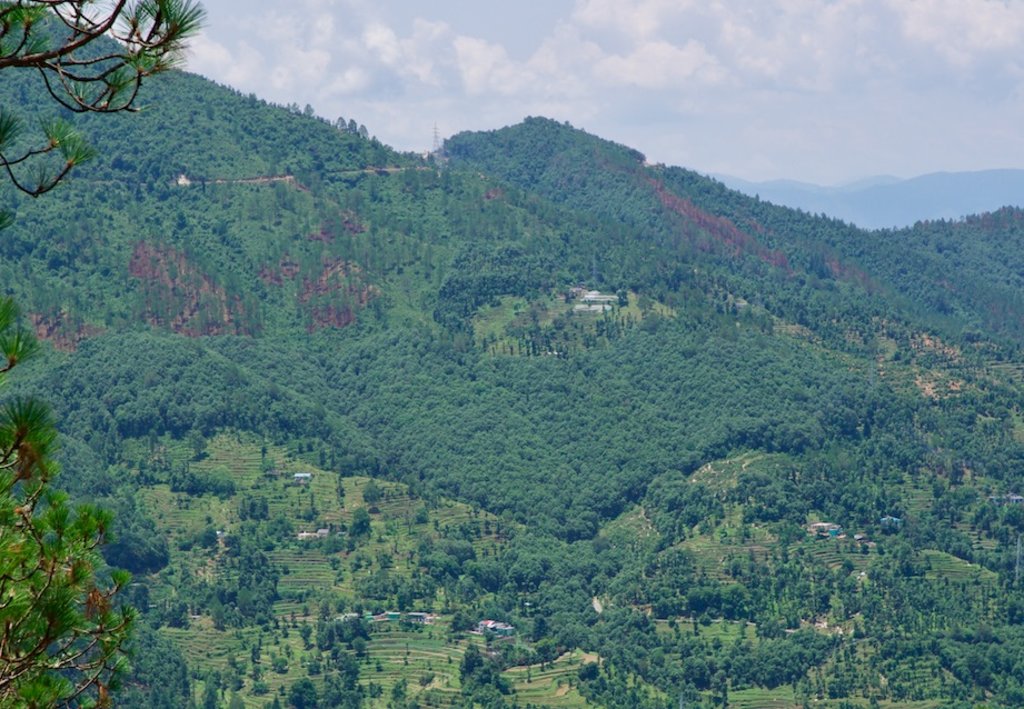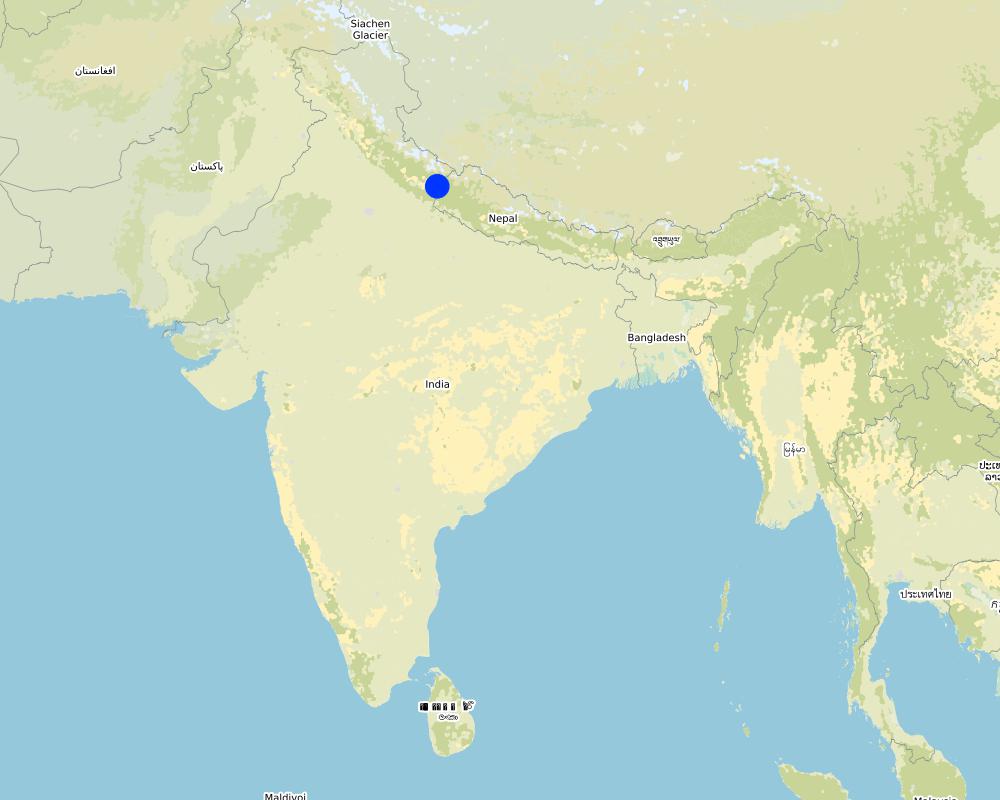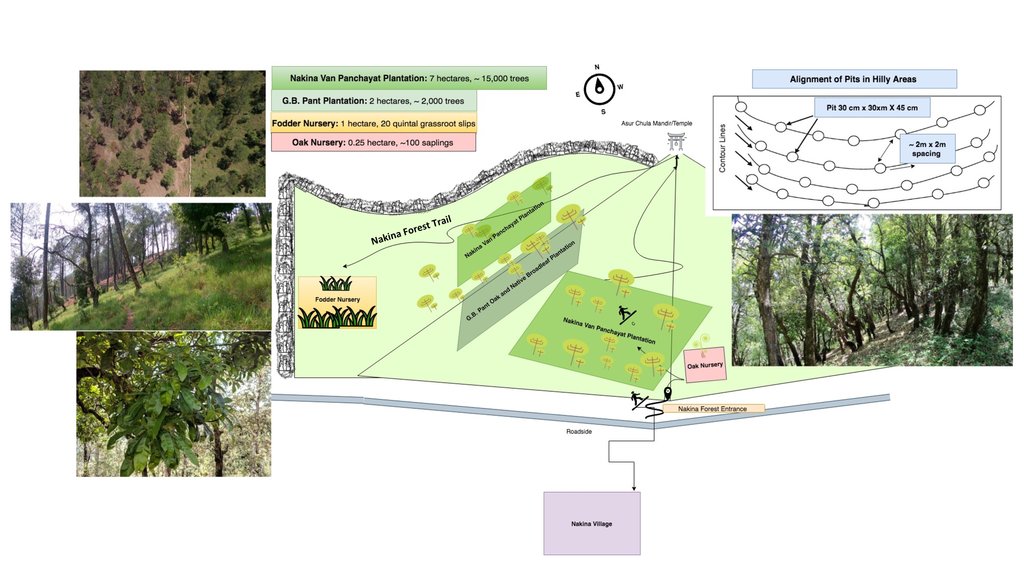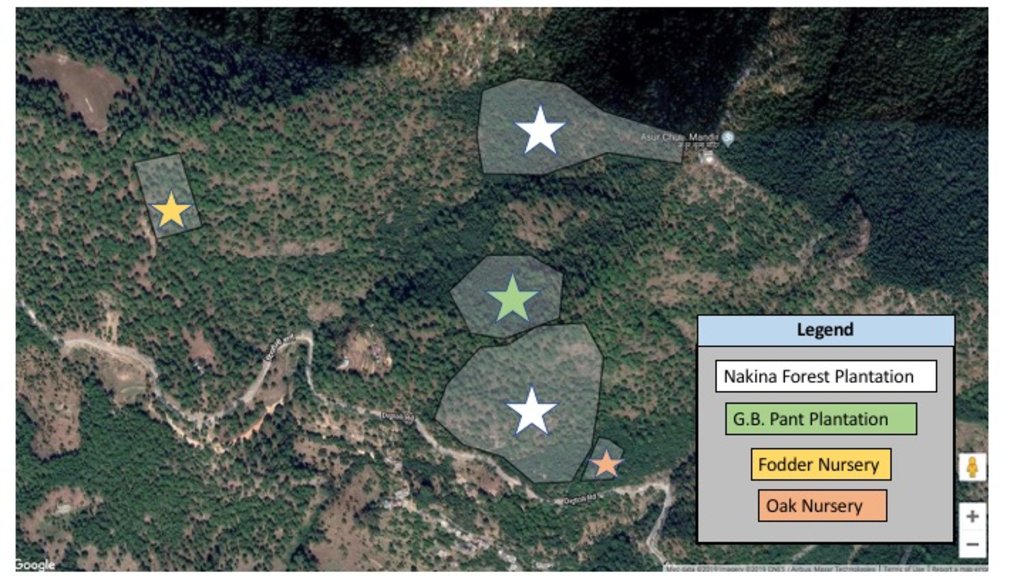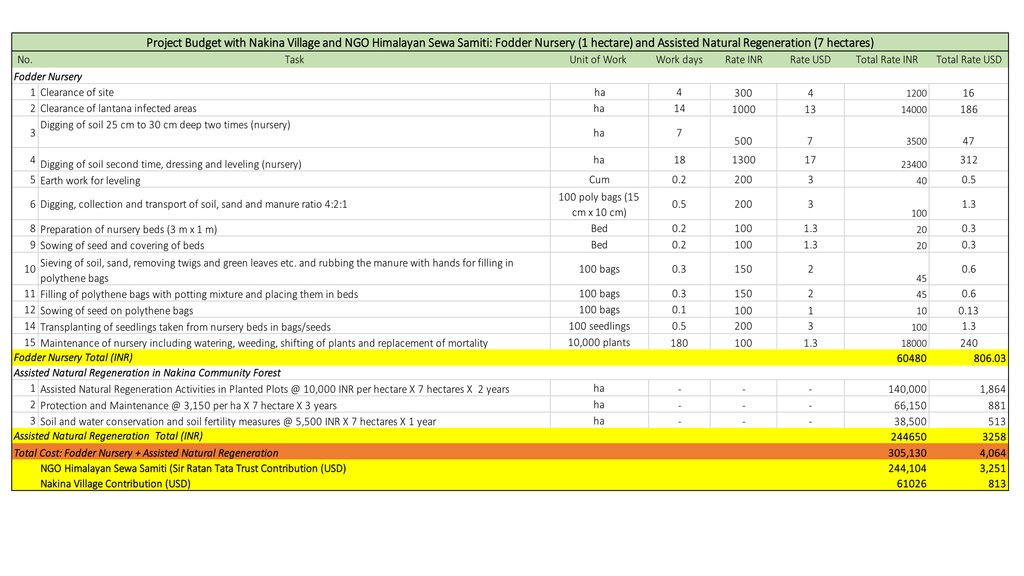Broadleaf Plantations, Assisted Tree Regeneration and Fodder Nurseries for Sustainable Forest Management [Индия]
- Создание:
- Обновить:
- Составитель: Jaclyn Bandy
- Редактор: –
- Рецензент: Hanspeter Liniger
Trees: Banj Oak (Quercus leucotricophora/glauca), Phalat (Quercus lanata), Fodder: Napier grasses, Bhimal (Grewia optiva), Khadik (Celtis australis)
technologies_5243 - Индия
Просмотреть разделы
Развернуть все Свернуть все1. Общая информация
1.2 Контактные данные специалистов и организаций, участвующих в описании и оценке Технологии
Ответственный (-ые) специалист (-ы)
землепользователь:
Joshi Jagdamba Prashad
Sarpanch (Head) of Nakina Community Forest (Van Panchayat)
Индия
землепользователь:
Pandey Basant Ballabh
Cucumber Farmer, Nakina Village
Индия
Название проекта, содействовавшего документированию/оценке Технологии (если применимо)
Onsite and Offsite Benefits of SLMНазвание организации (-ий), содействовавших документированию/оценке Технологии (если применимо)
ICIMOD International Centre for Integrated Mountain Development (ICIMOD) - НепалНазвание организации (-ий), содействовавших документированию/оценке Технологии (если применимо)
G.B. Pant Institute of Himalayan Einvironment & Development (G.B. Pant Institute of Himalayan Einvironment & Development) - Индия1.3 Условия, регламентирующие использование данных, собранных ВОКАТ
Составитель и ответственный(-ые) специалист(-ы) согласны с условиями, регламентирующими использование собранных ВОКАТ данных:
Да
1.4 Декларация по устойчивости описываемой Технологии
Вызывает ли описанная здесь Технология проблемы деградации земель настолько, что ее нельзя назвать природосберегающей?
Нет
Пояснения:
The land is suitable for afforestation and fodder nurseries. There are currently no signs of over exploitation with regards to natural resource use in the plantation area of the Nakina Forest.
1.5 Ссылка на Анкету (ы) по Подходам УЗП (документируется с использованием ВОКАТ)
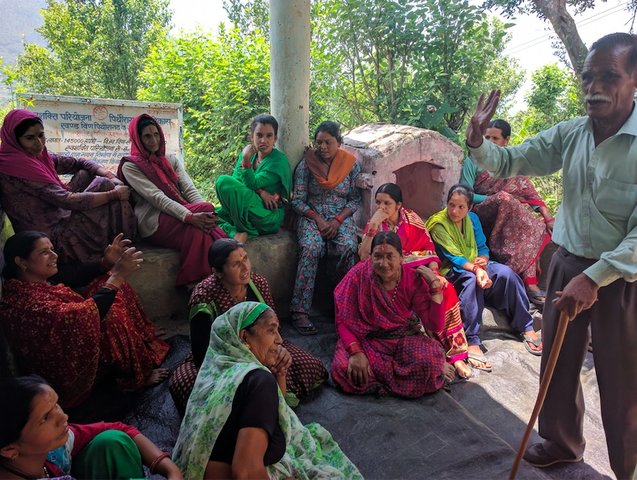
Community Forest Management in the Nakina Van Panchayat [Индия]
Van Panchayats or village forest councils are a impressive example of grassroots community management of natural resources, where a specific administrative unit is locally elected by community members who are responsible for the management of activities related to the forest.
- Составитель: Jaclyn Bandy

Naula Management and Conservation [Индия]
Naulas are shallow, four-sided stepped wells designed to collect water from subterranean seepages or springs and are used to meet domestic water needs by the local communities. Naula management and conservation encompasses a range of activities that preserve their structure and function.
- Составитель: Jaclyn Bandy
2. Описание Технологии УЗП
2.1 Краткое описание Технологии
Определение Технологии:
Natural assisted regeneration of broadleaved species, a small oak plantation and a fodder nursery have been established in the Nakina community forest (intervention area: 10 ha), supporting fodder tree species such as Banj Oak and Falyaat, as well as various subtropical temperate fodder grass species. This has improved the livelihood of the land-users by supporting the health and productivity of the forest, increasing the availability of fuel wood, fodder and groundwater for spring restoration.
2.2 Подробное описание Технологии
Описание:
1. The technology is applied in a natural environment and is located about 1km away from the settlement and the agriculture land of Nakina Village. The village has access to its own forest, which covers a geographical area of 114 hectare. Of this, 94 hectares come under the Village Forest Council, locally referred to as the Van Panchayat.
2. Characteristics of Technology:
a. Broadleaf species have been established over 7 hectares through natural assisted tree regeneration methods. These include Banj Oak (Quercus leucotrichophora), Falyaat (Quercus glauca), Koeraal (Bauhinia verigata), Bhimal (Grewia optiva), Padam Paaya (Prunus cerasoides), Haradh (Terminalia chebula), Reetha (Sapindus Mukorossi), Utees (Alnus napalensis), Ainyar (Lyonia ovalifolia), Khadik (Celtis australis).
b. Nakina Van Panchayat has made an oak plantation site of 2 hectares in collaboration with G.B. Pant Research Institute.
c. A fodder nursery covering 1 hectare hosts a variety of subtropical (Napier: Pennisetum purpureum, Aus, Ginni) and temperate grasses (Guchhi, Dolni, Italian rye: Lolium multiflorum). It was established with the assistance of the NGOs Swati Gramodyog Sansthan and the Himalayan Sewa Samiti. Extraction of fodder leaves and timber are restricted and regulations managed by the Van Panchayat (community forest council).
Purposes/functions:
-Increase trees and grasses to improve availability of fuel and fodder for community, as well as enrich biodiversity.
-Plantation is on a mountain slope (+25% slope), so it will help in preventing soil erosion and landslides.
-Improve soil and water conservation, prevention of surface run-off, support groundwater recharge and spring rejuvenation.
Major activities/Inputs needed to establish and maintain technology:
1. Activities for Assisted Natural Regeneration: protect and facilitate the growth of parent trees inherently present in the area and their regenerations, rather than establishment of entire plantation
2.Activities for the oak plantation: Selection and seed provision of appropriate tree species, clearing of vegetation and preparation of forest top soil, leveling of soil, digging of plantation pits, sowing weeding, watering, occasional pruning, propagation of trees from cuttings, dead sapling replacement, establishment of barrier/fencing for protection from fire.
3. Activities for fodder nursery:- Selection and seed provision of appropriate grass species and polypot materials, preparation of seedbeds; clearing of vegetation, removal of stones/large roots, ploughing/hoeing, mixing sand and compost on areas with poor soil, sowing seeds pre-monsoon, weeding and watering seedlings, propagation from seed or root cuttings, dead sapling replacement, establishment of barrier/fencing protection from fire.
Benefits/Impacts:
•Restores productivity and fodder/fuelwood availability
•Ecosystem stability
•Enhancement of biological diversity to degraded lands.
•Control landslide and soil erosion
•Control forest fire.
•Maintain wildlife habitat
•Increase livelihood of local people, decrease time spent collecting fodder
•Storage carbon on the forest help to reduce the CO2 in the atmosphere.
Likes:
This technology is properly functioning in the implementation area and local people have received many benefits from sustainable managing their natural resources rather than receiving incentives for institutional support, local people of the Nakina village are strongly active to protect the forest with their own coordination.
Dislikes:
1.Improve wildlife habitat, which may increase human wildlife conflicts as it is near to agriculture land and settlements.
2.Require regular maintenance activities, which require organization within the community and can increase periodic workload depending on level of participation
2.3 Фотографии, иллюстрирующие Технологию
2.5 Страна/ регион/ места, где применяется Технология, информация о которых собрана в данной Анкете
Страна:
Индия
Административная единица (Район/Область):
Uttarakhand
Более точная привязка места:
Nakina Village, Pithoragarh Bloc
Охарактеризуйте пространственное распространение Технологии :
- примененяется точечно/ на небольших участках
Технология применяется на ООПТ?
Да
Если да, укажите:
Nakina Van Panchayat (community forest)
Map
×2.6 Сколько лет применяется данная Технология
Если год начала применения Технологии достоверно неизвестен, дайте примерную оценку:
- 10-50 лет назад
2.7 Внедрение Технологии
Укажите, как именно Технология УЗП была внедрена:
- как инновация (инициатива) землепользователей
- через проекты/ внешнее вмешательство
Пояснения (тип проекта и т.д.):
After the Nakina Van Panchyat was established in 1952 they already had experience working on plantations. During the British-era, timber extraction, pine plantations and prescribed fire exploded in the region. Much of the oak forests were reverted to pine, and many broadleaved species like were overexploited for construction, fuelwood, and fodder. Nakina's self-initiated plantation efforts were done in hopes to restore it to its original state.
Other supporting organizations and institutions have recognized the need for further support for the following reasons: demand for fuel and fodder is still insufficient during the dry season, water scarcity has become a prevalent issue, and biological interventions are necessary to improve and sustain ecosystem services. Due to the expressed interest and dedication of the community, these projects have been accomplished.
3. Классификация Технологии УЗП
3.1 Основные цели и задачи реализации Технологии
- повышение производства
- снижение или предотвращение деградации земель, восстановление нарушенных земель
- сохранение экосистем
- защита бассейнов рек (приводораздельной части/ нижнего течения) – в сочетании с другими Технологиями
- сохранение/ повышение биоразнообразия
- снижение риска стихийных бедствий
- адаптация к изменению климата / экстремальным погодным явлениям и их последствиям
- создание благоприятных экономических условий
3.2 Текущий(-ие) тип(-ы) землепользования на территории, где применяется Технология
Комбинированное землепользование в пределах одной и той же земельной единицы:
Да

Пастбищные угодья
Интенсивный выпас/ выращивание кормов:
- Стойловое содержание/ нулевой выпас
Вид животных:
- крупный рогатый скот - молочный
- козы
Используется ли комплексное земледельческо-животноводческое хозяйство?
Да
Если да, укажите:
Compost was made from manure of livestock for plantation and fodder nursery preparation.
Продукты и услуги:
- мясо
- молоко

Леса/ лесистая местность
- (Квази-) Природные леса/ лесные массивы
- Лесопосадки, облесение
(Квази-) Природные леса / лесные массивы: Укажите тип управления:
- Выборочные рубки
Тип (полу-) естественного леса:
- естественная субтропическая сухая лесная растительность
Лесопосадки. облесение: Укажите происхождение и состав видов:
- Смешанные культуры
Тип лесонасаждений, облесение:
- субтропическая сухая лесная плантация - широколиственные
- Banj Oak (Quercus leucotricophora), Falyaat (Quercus glauca), Koeraal (Bauhinia verigata), Bhimal (Grewia optiva), Padam Paaya (Prunus cerasoides), Haradh (Terminalia chebula), Reetha (Sapindus Mukorossi), Utees (Alnus napalensis), Ainyar (Lyonia ovalifolia)
Являются ли указанные выше деревья лиственными или вечнозелеными?
- лиственные
Продукции и услуги:
- Древесина
- Дрова
- Другие продукты леса
- Выпас/ ощипывание молодых побегов и листьев
- Природоохранные/ защитные
3.3 Изменилось ли использование земель в связи с внедрением Технологии?
Изменилось ли использование земель в связи с внедрением Технологии?
- Нет (см. пункт 3.4)
3.4 Водоснабжение
Обеспеченность водой участков, где реализуется Технология :
- богарные земли
3.5 Категория УЗП, к которой относится Технология
- лесное хозяйство в естественных и измененных лесах
- лесное хозяйство в лесопосадках
- Улучшение почвенного/ растительного покрова
3.6 Мероприятия УЗП, выполняемые в рамках Технологии

Мероприятия с использованием растительности
- Р1: Древесный и кустарниковый покров
- Р2: Злаковые и многолетние травянистые растения
- Р3: Расчистка растительности
- Р4: Замещение или удаление чужеродных/ инвазивных видов
- Р5: Другие

управленческие мероприятия
- У1: Смена типа землепользования
- У2: Изменение формы/ интенсивности хозяйствования
- У3: Размещение с учетом природных и социально-экономических условий
- У5: Регулирование/ изменение видового состава
3.7 Основные проблемы деградации земель, на решение которых направлена Технология

водная эрозия почв
- ВЭп: поверхностная эрозия/смыв верхних почвенных горизонтов
- ВЭл: овражная эрозия / оврагообразование
- ВЭо: гравитационное перемещение горных пород / оползни
- ВЭд: косвенное воздействие водной эрозии

ухудшение химических свойств почв
- Хп: Снижение плодородия и уменьшение содержания органического вещества (вызванное не эрозией, а другими причинами)
- Хк: подкисление

ухудшение физических свойств почв
- Фу: уплотнение
- Фк: растрескивание и коркообразование
- Фп: запечатывание почв
- Фд: утрата био-продуктивных функций по другим причинам

биологическая деградация
- Бр: сокращение растительного покрова
- Бм: утрата местообитаний
- Бк: сокращение количества биомассы
- Бп: разрушительные последствия пожаров
- Бв: потеря природного разнообразия
- Бф: утрата биологической составляющей почв
- Бб: рост числа вредителей/болезней

деградация водных ресурсов
- Ва: почвенная засуха
- Вуп: изменение объема поверхностного стока
- Вуг: изменения уровня грунтовых вод/ водоносных горизонтов
- Взп: снижение качества поверхностных вод
- Взг: снижение качества грунтовых вод
3.8 Предотвращение и снижение деградации земель, или восстановление нарушенных земель
Укажите цель Технологии по отношению к деградации земель :
- снижение деградации земель
- восстановление/ реабилитация нарушенных земель
4. Технические характеристики, мероприятия по практической реализации, вложения и стоимость
4.1 Технический рисунок, иллюстрирующий Технологию
Спецификация (пояснения к техническому рисунку):
G.B. Pant Plantation: 2 Hectare, pits of (30 cm X 30cm X 45cm) were dug along contour lines, spacing of pits is not less than 2x2 m, about 2,000 Quercus saplings were planted.
Nakina Broadleaf Plantation: 7 Hectare, pits of (30 cm X 30cm X 45cm) were dug along contour lines, spacing of pits is no less that 2x2 m, about 15,000 trees have been planted and the forest is being continually managed in the area.
Species: Banj Oak (Quercus leucotrichophora), Falyaat (Quercus glauca), Koeraal (Bauhinia verigata), Bhimal (Grewia optiva), Padam Paaya (Prunus cerasoides), Haradh (Terminalia chebula), Reetha (Sapindus Mukorossi), Utees (Alnus napalensis), Ainyar (Lyonia ovalifolia), Khadik (Celtis australis)
Fuelwood cutting (lopping), fodder collection, and selective clear cutting for Quercus leucotrichophora and other broadleaved species is done between Nov- April.
Fodder Nursery: 20 Quintals (20,000 kg) of various grassroot slips over 1 Hectare. This provides +175 tonnes/year. (Subtropicals species: napier, aus, ginni, Temperate species: guchhi, dolni, italian rye)
Planting: Grasses are planted during the months of June-July at the advent of rainy season, about 10 cm deep vertically and at a spacing of 45 x 30 cm apart.
Propagation: grasses forms clumps during its growth period. The clump when broken gives a number of small units known as slips, which are the units of propagation and on planting, they establish as individual plants. While preparing the slips for planting, fibrous roots and leaves are be trimmed off. Cuttings with 2 nodes from the middle portion of moderately matured stems (3 – 4 months old) were planted in a slanting position at one side of the ridges with one node buried in the soil. The underground node develops roots and shoots while the upper node shoots only. The soil around the stem is pressed tightly. Farm yard manure is applied after harvest (application rate varies; estimation is 5-8 tonnes). Annually about 6 to 8 cuts are possible.
Oak Nursery: 0.25 ha. The nursery bed is rectangular and measures about 100m x 25 m. The seedlings are uprooted by hand from a seedbed and transplanted (bare-root transplanting). The nursery is on a gently sloping land (23%). Seedlings with poor lateral root development are culled out.
Oak Plantation Alternative:
Acorns are collected and put in water for 24 hours. Acorns that sink are immediately sown in a well tilled seedbed 2-5 cm deep, 15 cm from each other and covered with a thin layer of firm soil. Beds are mulched with straw or leaves. However, not every acorn will germinate and animal predation of acorns can be an issue. In general, probability of success is lower than with seedlings.
Автор:
Jaclyn Bandy
Дата:
25/07/2019
Спецификация (пояснения к техническому рисунку):
Google Map of Plantations and Fodder Nursery locations
Автор:
Jaclyn Bandy
Дата:
25/07/2019
Спецификация (пояснения к техническому рисунку):
Project Budget with Nakina Village and NGO Himalayan Sewa Samiti: Fodder Nursery, 1 hectare and Assisted Natural Regeneration 97 Hectares)
(Citation: Detailed Project Report: Natural Resource Based Livelihood Project in the Gorang Ghati Cluster, NGO Himalayan Sewa Samiti, Submitted to: Sir Ratan Tata Trust (SRTT) Forest Works Manual, 2015 Forest Research Institute, Dehradun, Uttarakhand)
Автор:
J Bandy
Спецификация (пояснения к техническому рисунку):
Project Budget for Afforestation of Nakina Community Forest and G.B. Pant Institute of Himalayan Environment and Development: Broadleaf Plantation (2 hectares)
(Citation: Forest Works Manual, 2015 Forest Research Institute, Dehradun, Uttarakhand)
Автор:
J Bandy
4.2 Общая информация по необходимым вложениям и стоимости
Уточните, как рассчитывались затраты и вложения:
- на площадь, где применяется Технология
Укажите размер и единицу площади:
Afforested Community Forest: 7 hectares, G.B. Pant Plantation: 2 hectares, Fodder Nursery: 1 hectare
другая/ национальная валюта (название):
INR
Если это необходимо, укажите обменный курс от доллара США к местной валюте (например, 1 доллар США = 79,9 бразильского реала): 1 доллар США =:
70,0
Укажите среднюю дневную заработную плату наемных работников:
400 INR
4.3 Мероприятия, необходимые для начала реализации
| Деятельность | Время (сессия) | |
|---|---|---|
| 1. | Plantations: Survey, demarcation, clearance of shrubs, bushes, Lantana (invasive species) | Pre-monsoon |
| 2. | Earth work for leveling, Digging pits (30 cm X 30cm X 45cm) along contour lines, spacing of pits no less that 2x2 m, filling of pits with soil/manure mixture | Early June |
| 3. | Planting of saplings: roots of the plants kept straight and the plant put straight in vertical position; done by digging with the help of a stick or small crow bar | Early July |
| 4. | Note: Species like Akhrot, Angu, Maple, Pangar, Poplar, Salix, Utis etc. are planted in winter months | January/February |
| 5. | Dead, dying or dry plants are replaced within 15 days of completion of planting work | Mid June |
| 6. | Thanwalas (semicircular pit) about 15 cm deep, 25-30 cm apart from the plant were dug for rainwater retention/infiltration | Mid June |
| 7. | Weeding after first significant rains | Monsoon |
| 8. | Fodder Nursery: Survey, demarcation, clearance of shrubs, bushes, Lantana (invasive species) | Pre-monsoon |
| 9. | Plowing/hoeing land, collection and soil, sand, manure preparation (4:2:1 ratio) and seedbed preparation | Pre-monsoon |
| 10. | Planting of each cane/rootsplit in holes 15-30 cm deep, with a spacing of 0.5m x 0.5m | Pre-monsoon |
| 11. | Cutting and Harvesting |
Пояснения:
Oak Plantation: Seeds are collected from dominant oak trees that exhibit superior phenotypic traits such as tall straight trunks, good diameter growth rates and well-developed crowns (branches/leaves)
Cuttings:
4.4 Вложения и затраты, необходимые для начала реализации
| Опишите затраты | Единица | Количество | Затраты на единицу | Общая стоимость на единицу | % затрат, оплаченных землепользователями | |
|---|---|---|---|---|---|---|
| Оплата труда | Plantation Community Manual labour | person-days | 400,0 | 400,0 | 160000,0 | 50,0 |
| Оплата труда | Skilled labour (advisor, experts) | person-days | 7,0 | 2000,0 | 14000,0 | |
| Оплата труда | Fodder Nursery Raising | Total Cost | 1,0 | 25000,0 | 25000,0 | 25,0 |
| Оборудование | Axe, Crow bar, Wheel barrow | pieces | 10,0 | 1500,0 | 15000,0 | 100,0 |
| Оборудование | Digging forks, Hammers, Hoes, Spade | pieces | 10,0 | 1500,0 | 15000,0 | 100,0 |
| Оборудование | Scissors, Pruning knives/shears, Budding and Grafting Knives/Tape | pieces | 10,0 | 700,0 | 7000,0 | 50,0 |
| Посадочный материал | Fodder Grass/20 Quintals of Grassroot slips | Total Cost | 1,0 | 45000,0 | 45000,0 | 50,0 |
| Посадочный материал | Plantation Material, 3.88 INR per Sapling x 1000 Sapling per hectare x 7 hectare | Total Cost | 1,0 | 27160,0 | 27160,0 | 50,0 |
| Удобрения и ядохимикаты | Soil/Water Conservation and Soil Fertility Measures: 5,500 INR per Hectare x 2 | Total Cost | 1,0 | 11000,0 | 11000,0 | 100,0 |
| Удобрения и ядохимикаты | Nakina Forest: Assisted Natural Regeneration preparation and composting | Total Cost | 1,0 | 2000,0 | 2000,0 | 100,0 |
| Удобрения и ядохимикаты | Fodder Nursery composting | Total Cost | 1,0 | 1000,0 | 1000,0 | 100,0 |
| Другие | Plantation Transportation, Pitting, Planting: 6.9 INR per plant X 1000 sapling x 2 hectare | Total Cost | 1,0 | 13800,0 | 13800,0 | 50,0 |
| Другие | Fodder Nursery (Rootstock Purchase, Transportation) | Total Cost | 1,0 | 5500,0 | 5500,0 | 50,0 |
| Другие | Nakina Village: Assisted Natural Regeneration Activities in Planted Plots, 10,000 INR per hectare X 7 hectares x 3 years | Total Cost | 1,0 | 30000,0 | 30000,0 | 100,0 |
| Общая стоимость запуска Технологии | 371460,0 | |||||
| Общие затраты на создание Технологии в долларах США | 5306,57 | |||||
Если землепользователем оплачено менее 100% затрат, укажите, кем покрывались остальные затраты:
UTFD (Forest Department): funds mobilized by the MNEGRA (Mahatma Gandhi National Rural Employment Guarantee Act), JICA, G.B. Pant, NGO Himalayan Sewa Samiti (Sir Ratan Tata Trust's Contribution)
Пояснения:
For G.B. Pant Plantation and Nakina Forest Plantation:
On average we estimated a maximum of 10 people worked on establishing the technology/day = 400 x 10 = 4000 (labor cost/day): 4,000 X 40 days = 160,000 INR Total Cost
Some of the community laborers were compensated for the initial phase of establishing the plantation with G.B. Pant Plantation, but for the Nakina Plantation most of the work was voluntary by the community over many years. Nakina Van Panchayat has a joint bank account (Almora Urban Cooperative Bank) with officials from the Forest Department. Money from the Forest Department/ JICA (Japanese International Cooperation Agency) gets deposited there. A portion of this is used to compensate the village workers (~400 INR/day) .
NGO Himalayan Sewa Samiti (HSS) was involved in supporting the fodder nursery and some plantation support.
For the original project budget outline for the Fodder Nursery, please see the attached document in the Technical Drawing section from the NGO HSS.
For further details on the plantation budget, please see the tables in the Technical Drawing section from the Forest Works Manual/Schedule of rates for forest work in Uttarakhand.
4.5 Поддержание/ текущее обслуживание
| Деятельность | Сроки/ повторяемость проведения | |
|---|---|---|
| 1. | Second weeding done in September, followed by a third weeding after the winter rains. | Post-monsoon |
| 2. | A Chowkidar (forest watch guard) is deputed for five years in the plantation area to look after it | Post-planting |
| 3. | Periodical weeding and removal of grasses suppressing the plants, maintenance and repair of inspection paths | Year round |
| 4. | Fire Control: Keeping regular watch over the plantation area during the fire season, cleaning of the outer periphery of the plantation area in two meter width | Dry season |
| 5. | Collective help and co-operation with the villagers in the protection of the plantation; checks on fodder extraction/allowance, prevention of trespassers (human/wildlife) | Year round |
| 6. | During the second year, dead plants are replaced by planting fresh saplings (ca. 20%) | Onset of monsoon |
| 7. | Fodder grasses: propagation from cuttings or from root slips | |
| 8. | Fodder Grasses: Harvesting of grasses every 6-8 weeks, maintaining a stubble height of 5-10 cm from the ground level at each harvest to avoids weakening of root system |
4.6 Стоимость поддержания/ текущего обслуживания ( в год)
| Опишите затраты | Единица | Количество | Затраты на единицу | Общая стоимость на единицу | % затрат, оплаченных землепользователями | |
|---|---|---|---|---|---|---|
| Оплата труда | Maintenance of nursery | Total Cost/Year | 1,0 | 3000,0 | 3000,0 | 25,0 |
| Оплата труда | Maintenance of plantations | Total Cost/Year | 1,0 | 4000,0 | 4000,0 | 25,0 |
| Общая стоимость поддержания Технологии | 7000,0 | |||||
| Общие затраты на поддержание Технологии в долларах США | 100,0 | |||||
Если землепользователем оплачено менее 100% затрат, укажите, кем покрывались остальные затраты:
UTFD (Forest Department): funds mobilized by the MNEGRA (Mahatma Gandhi National Rural Employment Guarantee Act), JICA, NGO Himalayan Sewa Samiti (Sir Ratan Tata Trust's Contribution)
Пояснения:
Please see estimated maintenance costs attached in references.
In general, the land users bear the labor costs of maintenance, but they received inputs and other support to maintain the fodder nursery and plantations for a few years (2-3) after the projects were executed. Otherwise, remaining funds in the joint bank account with Nakina Van Panchayat and UTFD/JICA are accessed for necessary supplies and labor compensation.
4.7 Наиболее значимые факторы, влияющие на стоимость затрат
Опишите наиболее значимые факторы, влияющие на стоимость затрат:
-Length and amount of available funding, as plantation projects require substantial investment and long term care.
-Damage or survival rate of the saplings/trees/fodder species can be severely affected by climatic, anthropogenic, or wildlife disturbances. The success and cost of a plantation and nursery project can vary widely depending on size, topographic characteristics, access, labor availability and overall appropriateness of site selection.
5. Природные и социально-экономические условия
5.1 Климат
Среднегодовое количество осадков
- < 250 мм
- 251-500 мм
- 501-750 мм
- 751-1000 мм
- 1001-1500 мм
- 1501-2000 мм
- 2001-3000 мм
- 3001-4000 мм
- > 4000 мм
Укажите среднегодовое количество осадков (если известно), мм:
1500,00
Пояснения/ комментарии по осадкам:
Monsoon- mid-June to mid-September; July and August are the rainiest months and the temperature is warm and moist; between 70-85% of the annual precipitation occurs in the monsoon season
Seasons
a. Winter or Cold weather (mid Dec. - mid March)
b. Summer or hot weather (mid March - mid June)
c. Season of general rains (South - West monsoon season)
d. Season of retreating monsoon (mid September to mid November)
Укажите название соответствующей метеостанции:
India Meteorological Department, Meteorological Centre Dehradun
Агроклиматическая зона
- Умеренно-влажная
The overall climatic condition in the Pithoragarh district is governed by the southwest monsoon. It has a sub-tropical to temperate climate, with three pronounced seasons; summer, winter, and monsoon. The hilly terrain of the Himalayan region has snow cover and is cold during winter with snowfall normally occurring during the months of December to March.
Temperature- The temperature ranges from 0°C to 10°C in winter and from 8°C to 33°C in summer season. However, there is no meteorological observatory in the district. The account of the climate is based mainly on the records of the observations in the neighboring districts where similar meteorological conditions prevail. Variations in temperature are considerable from place to place and depend upon elevation as well as aspect. As the insolation is intense at high altitudes, in summer temperatures are considerably higher in the open than in the shade.
5.2 Рельеф
Склоны (преобладающие):
- пологие (0-2%)
- покатые (3-5%)
- покато-крутые (6-10%)
- крутые (11-15%)
- очень крутые (16-30%)
- чрезвычайно крутые (31-60%)
- обрывистые (>60%)
Формы рельефа:
- плато/ равнины
- гребни хребтов/холмов
- склоны гор
- склоны холмов
- подножья
- днища долин
Зона высотной поясности:
- 0-100 м над уровнем моря
- 101-500 м н.у.м.
- 501-1000 м н.у.м.
- 1001-1500 м н.у.м.
- 1501-2000 м н.у.м.
- 2001-2500 м н.у.м.
- 2501-3000 м н.у.м.
- 3001-4000 м н.у.м.
- > 4 тыс. м н.у.м.
Укажите, приурочено ли применение Технологии к специфическим условиям:
- в ситуациях вогнутого рельефа
Комментарии и дополнительные сведения по условиям рельефа/ топографии :
Altitude of evaluated sites: 1850-1990m
Slope: 23-30%
5.3 Почвы
Средняя мощность почв:
- поверхностные (0-20 см)
- неглубокие (21-50 см)
- умеренно глубокие (51-80 см)
- глубокие (81-120 см)
- очень глубокие (> 120 см)
Гранулометрический состав (верхнего горизонта):
- грубый крупнозернистый/ лёгкий (песчаный)
- средние фракции (суглинистый, супесчаный)
Гранулометрический состав (на глубине более 20 см):
- средние фракции (суглинистый, супесчаный)
Содержание органического вещества в верхнем горизонте:
- среднее (1-3%)
- низкое (< 1%)
Если возможно, приложите полное описание почв или укажите доступную информацию, например тип почв, рH/ кислотность почв, ёмкость катионного обмена, содержание азота, содержание солей и т.д.
Mountain/hill soils are a collective name given to various types of soils found under the following conditions :
-under sub-tropical, temperate and sub-alpine conditions
-under various forest types
Characteristics: very thin, fertile, and may be less than a centimeter deep on steep slopes; they are mixed with pebbles, shingles (a mass of small rounded pebbles), and gravels; they have a low-medium water holding capacity. Angular and subangular fragments of parent rock may be found mixed with the lower layers of the mountain and hill soils.
Texture: varies from loamy to sandy loam.
Soil Reaction: ranges from acidic to neutral (pH 4.6 to 6.5)
Organic Matter content: 1-5%
Ferrugenous red roils are found in this district and are well developed over Himalayan rocks (quartzite, biotite schist, amphibolite schist). They are free of carbonates and deficient in nitrogen, humus and phosphorus, light textured, porous, and friable (brittle/crumbly). The soil depth ranges from about 10cm-75 cm. These soils may be grouped into two on basis of morphology
1. Red earths- loose, friable topsoil rich in secondary concretions (hard, compact mass of matter formed by the precipitation of mineral cement within the spaces between particles, and is found in sedimentary rock or soil)
2. Red loam- argillaceous soils having a blocky structure (argillaceous minerals may appear silvery upon optical reflection and are minerals containing substantial amounts of clay-like components, e.g. argillaceous limestones are limestones consisting predominantly of calcium carbonate, but including 10-40% of clay minerals)
Brown soil: is found particularly under dense broadleaved temperate and sub-alpine forests. There occurs a thick layer of humus on the forest floor (made of decomposed leaves, branches, twigs) and the topsoil is extremely rich in humus
Podsolic Soil: soil that has developed in humid/temperate conditions usually under coniferous forests (e.g. deodar, blue pine, fir, spruce) over quartzite, granites, schists and gneiss.
(Citation: Kumaun: The Land and the People, Sharad Singh Negi (1993)
5.4 Доступность и качество воды
Уровень грунтовых вод:
5-50 м
Доступность поверхностных вод:
средняя
Качество воды (без обработки):
питьевая вода хорошего качества
Качество воды относится к:
грунтовые воды
Является ли солёность воды проблемой?
Нет
Происходят ли периодические затопления территории?
Нет
Комментарии и дополнительная информация по качеству и количеству воды:
Quantity: Water crisis has been a perennial problem in both the rural and urban areas of the Pithoragarh district
There is scarcity of safe drinking water of the villages in the study area. Hand pumps are often not functioning, pipe-water schemes are unreliable and the spring discharges have reduced during the dry season. Hand-pumped water often has a high iron content and bitter taste. Poor quality of groundwater in some of the naulas is mainly due to misuse and/or disuse of the structures.
A block-district groundwater resource estimation could not be carried out as the area is hilly (with slope >20%) and in major part aquifers are small, isolated bodies, and groundwater abstraction is done mainly through hand pumps and springs with small discharges.
However, we collected some physicochemical parameters that indicate the water (sourced from springs) is of good quality:
Water Quality Parameters of Springs:
pH: 6.29-8.18
Temp: 19.0-23.5 ºC
Electrical Conductivity: 109-504 µmsiemens
Total Dissolved Solids: 75-385 ppm
5.5 Биоразнообразие
Видовое разнообразие:
- средняя
Разнообразие местообитаний:
- средняя
Комментарии и дополнительная информация по биоразнообразию:
Uttarakhand has more than 7000 species of medicinal plants and 500 species of fauna. Floral diversity contributes 31% of total floral density of India. Fauna contributes just 1.58% of the total faunal density of the country. There are 119 endemic species of flowering plants in the state that exhibited 2.35% endemism and 35 faunal endemic species. Because it lies at the juncture of India, Nepal and the Tibeten Autononmous region, there often cases of poaching and smuggling of wildlife contrabands, including bear bile, musk pods and leopard skins through the borders. Yarsa Gumba Ophiocordyceps sinensis, commonly known as Caterpillar Fungus, is also illegally traded transboundary in the region, together with various plant species. Due to anthropogenic impacts, changes is soil quality, and climatic elements, the biodiversity of our study site is not as high as in other areas of the Pithoragarh district.
Citation: Sundriyal, M. & Sharma, B. (2016). Status of Biodiversity in Central Himalaya, Applied Ecology and Environmental Sciences, 4( 2), 37-43.
5.6 Характеристика землепользователей, применяющих Технологию
Осёдлый или кочевой:
- Осёдлый
Рыночная ориентация производства:
- натуральное хозяйство (самообеспечение)
- смешанный (натуральный / коммерческий)
Доходы из других источников:
- 10-50% всех доходов
- > 50% всех доходов
Относительный уровень достатка:
- плохой
Индивидуальное или коллективное хозяйство:
- группа/ община
Уровень механизации:
- ручной труд
Пол:
- женщины
- мужчины
Возраст землепользователей:
- молодёжь
- средний возраст
- пожилой
Укажите другие важные характеристики землепользователей:
With recent development in Pithoragarh, an influx of funds coming from outside sources has caused a decline in the importance of agriculture production, which in now marginalized, based on female labour, and mainly conducted for subsistence with little surplus to sell. High caste men do not work in cultivation at all, and male tasks such as ploughing are performed by the Scheduled Caste.
Although most women are still cultivating, their work has lost economic importance. For most families, the produce does not cover the needs of the household and surplus must be bought from the market. Many of the terraces that were formerly fruit orchards (mainly citrus) have been completely abandoned. Farming is less intensive and landholdings are small and fragmented. The main crops are wheat, millet, and pulses, but yields are low as the land is not irrigated. Less livestock (cows, goats, buffalo) is kept because of the labor involved. Very little capital is returned to farming. Crops produced for the markets in the plains are replacing traditional crops to sustain the household.
With exposure to the“Modern” lifestyle, new values have also been accepted. Two children are the norm (the ideal being one son and one daughter, but at least one son in a must). Although access to education is quite good, it does not seem to result in working careers for women.
5.7 Средняя площадь земель, используемых землепользователями с применением Технологии
- < 0,5 га
- 0,5-1 га
- 1-2 га
- 2-5 га
- 5-15 га
- 15-50 га
- 50-100 га
- 100-500 га
- 500-1000 га
- 1000-10000 га
- > 10000 га
Считается ли это мелким, средним или крупным хозяйством (по местным масштабам)?
- мелкое
5.8 Собственность на землю, права на земле- и водопользование
Землевладелец:
- общинная/ поселковая
Право землепользования:
- общинное (контролируемое)
Право водопользования:
- неограниченное (неконтролируемое)
- общинное (контролируемое)
Права на землепользование основаны на традиционной правовой системе?
Да
Поясните:
Under the Kumaun Panchayat forest rules of 1931 (amended in 1976): A Van Panchayat, (community forest council), can be formed out of non-private land within the settlement boundaries of a village. Accordingly, all villagers are members of the VP upon their approval by a Sub-Divisional Magistrate under the state Revenue Department. The members are collectively referred to as the general body, which selects the management committee members through a democratic process.
Пояснения:
5-9 elected members assume control of the forest and the extent of villager use. They additionally raise funds and mobilize the village to protect and support sustainable land use. Presently 12,089 Van Panchayats are entrusted with the management of over 5,449.64 km2 of forests.
5.9 Доступ к базовым услугам и инфраструктуре
медицинское обслуживание:
- плохой
- средний
- хорошая
образование:
- плохой
- средний
- хорошая
технические консультации:
- плохой
- средний
- хорошая
занятость (вне хозяйства):
- плохой
- средний
- хорошая
рынки:
- плохой
- средний
- хорошая
электроснабжение:
- плохой
- средний
- хорошая
транспорт и дорожная сеть:
- плохой
- средний
- хорошая
водоснабжение и канализация:
- плохой
- средний
- хорошая
финансовые услуги:
- плохой
- средний
- хорошая
Пояснения:
The situation of infrastructure is difficult and inconsistent in the hill regions because of the terrain. The major infrastructural issues are drinking water and irrigation facilities, electricity, transportation and communication facilities and social infrastructure (housing and education). As for financial services, only the State Bank of India (SBI) is active in the hill regions where it is trying to achieve the objective of 100% financial inclusion. Some villages mentioned buying into into agricultural insurance in the past, however this was a temporary enterprise and they were never compensated after extreme climatic events that occurred and damaged over 70% of their crop.
Though infrastructure and education has generally improved over the years, institutional and marketing networks in the region aimed at supporting hill-farmers are lacking.
6. Воздействия и заключительные положения
6.1 Влияние Технологии УЗП в пределах территории ее применения
Социально-экономическое воздействие
Продуктивность
производство кормов
Количество до применения УЗП :
2 ton/ha
Количество после применения УЗП:
30 ton/hectare
качество кормов
производство продуктов животноводства
производство древесины
качество леса/ древостоя
Комментарий/ пояснения:
Tree lopping for fodder was decreased by 15%
площадь, используемая для производства продукции
управление землями
Доходы и затраты
сельскохозяйственные издержки
Комментарий/ пояснения:
Decreased the amount of supplementary fodder required for livestock. The amount of grasses, fodder, and fuelwood has increased significantly.
объем работ
Комментарий/ пояснения:
Less time spent collecting forest resources, as the area where the technology is near the village and supports fodder/fuelwood growth (broadleaf forest/oak nursery area)
Социальное и культурное воздействие
продовольственная безопасность/ самообеспечение
Комментарий/ пояснения:
Improved self sufficiency of village, as the technology has helped increase animal productivity (more fodder, better quality) and increased water availability.
состояние здоровья
Комментарий/ пояснения:
Water condition has improved and people spend less time spent collecting fodder in the forest.
права на землю/воду
Комментарий/ пояснения:
There is less friction between the villages of Bhurimuni and Nakina. Nakina did not have to go ask for permission to access the Bhurimuni Naula for water during the dry season.
культурные возможности
Комментарий/ пояснения:
The improvements of forest resource security and resilience to disasters/climatic extremes have allowed the villagers have more free time to build up a communal gathering area for ceremonial events and festivals around the Vaishnavi Temple.
возможности отдыха и рекреации
Комментарий/ пояснения:
Recreation opportunities for villagers have increased. Particularly women, (some of whom are involved in a self help group and active Van Panchayat members), expressed that they saved approximately 1-2 hours/day in fodder collection time.
местное самоуправление
Комментарий/ пояснения:
The partnerships formed between land-users, the Nakina Van Panchayat, the Forest Department and external institutions are leading examples of necessary cooperation between all levels of governance for project harmonization.
знания в области УЗП/ деградации земель
Комментарий/ пояснения:
People are taking forest management seriously and making innovative plans for further SLM interventions, whether it be community-initiated or with the help of external institutions/agencies.
смягчение конфликтов
Комментарий/ пояснения:
Conflict has decreased in the village do to increased availability of resources. The overall morale of the village is better and less frantic due to an improvement in dodder, fuel and water provision. This has further enhanced cooperation for interventions that require participation and effort in the community forest.
Экологическое воздействие
Водный цикл/ поверхностный сток
количество воды
Комментарий/ пояснения:
The technologies improve water holding capacity of the soil by decreasing runoff velocity and improve overall water storage.
сбор воды/ водоудержание
поверхностный сток
уровень грунтовых/ подземных вод
испарение
Почвы
влажность почв
Комментарий/ пояснения:
Soil moisture of common land was increased by about 15%
почвенный покров
утрата почв
Комментарий/ пояснения:
Trees and other vegetation has helped mitigate displacement of soil from upstream areas to the lowlands
аккумуляция почвенного материала (намыв, эоловая, и др.)
образование корки на поверхности почв/ запечатывание
уплотнение почв
круговорот/ восполнение питательных веществ
почвенное / подземное органическое вещество/ углерод
кислотность
Биоразнообразие: растительность, животный мир
Растительный покров
Комментарий/ пояснения:
Vegetation growth and cover has improved due to more shade and water availability
биомасса/ содержание углерода в надземной биомассе
разнообразие флоры
Комментарий/ пояснения:
Increased species diversity due to improved moisture availability, soil conditions and microclimate.
инвазивные чужеродные виды
разнообразие фауны
Комментарий/ пояснения:
Provide more water and habitat for small animals/birds.
полезные виды
Комментарий/ пояснения:
Healthy afforested areas provide more water, habitat, and protection for microorganisms and insect species. They support native grasses and vegetation.
разнообразие местообитаний
Климат и снижение риска стихийных бедствий
оползни и селевые потоки
Комментарий/ пояснения:
Incidents of landslides decreased due to less surface flow velocity and soil destabilisation. Villagers also noted that there were that less displaced soil and sediment accumulation in the ravine that normally incurs damage from upstream debris flow in the monsoon season.
влияние засух
Комментарий/ пояснения:
Drought impacts decreased due improved surface and subsurface hydrological functioning in the upper watershed catchment areas. This increased microwatershed/ springshed groundwater stores and enhanced stream and spring flows in the dry season.
воздействие ураганов, проливных дождей
Комментарий/ пояснения:
Erosion impacts from extreme rain storms is reduced by decreasing flow velocity
выбросы углекислого газа и парниковых газов
Комментарий/ пояснения:
Carbon storage is increased by the plantation. It has been previously studied that Uttarakhand Van Panchayat forests sequester carbon at the average rate of 3.5 t ha -1 yr-1. This varies depending on forest distribution, species and land management.
.
риск пожаров
Комментарий/ пояснения:
The forest intervention area is protected by the villagers from anthropogenic and wild fires, therefore the forest has rehabilitated more quickly and has a lower risk of burning due to improved green vegetation cover and less flammable pine needle accumulation. In the case of pine forests, pine needles are a major source of fuel for fire and the removal of buildup remains a major challenge for the land users.
микроклимат
Комментарий/ пояснения:
Because of the interventions, vegetation/biomass, soil cover and water availability has improved and created a more suitable microclimate for microorganisms, plants, animals and people. The microclimate has improved due to decreased surface temperatures from exposed, bare soil or ground that is covered with pine needles. This improved microclimate is visible, as it has additionally allowed a wider range of species (grasses, shrubs, wildflowers, insects, birds) to inhabit the intervention site.
6.2 Влияние Технологии за пределами территории ее применения
доступность воды
Комментарий/ пояснения:
Improved spring discharge in the peak dry season
надежность и постоянство водотоков
Комментарий/ пояснения:
Bhind and Vaishnavi Naulas (springs) have improved discharge in the peak dry season. According to villagers, there was little to no water available in May/June, and since 10 years the flow has returned due to the plantation efforts combination with structural technologies.
подтопление ниже по течению
Комментарий/ пояснения:
impact of flash flood is minimized
отложение наносов ниже по течению
Комментарий/ пояснения:
Helped slow down sediment and runoff
буферная/ фильтрационная способность
Комментарий/ пояснения:
No direct evidence, but statements from the locals indicate that there are less sediments in the spring water ( due to improved soil infiltration and buffering capacity)
ущерб прилегающим полям
Комментарий/ пояснения:
Less damage from runoff
ущерб объектам инфраструктуры общего/ частного пользования
Комментарий/ пояснения:
Decreased intensity of runoff on the roadside and settlement below
6.3 Подверженность и чувствительность Технологии УЗП к постепенным изменениям климата и экстремальным погодным явлениям/ стихийным бедствиям, связанным с изменением климата (в понимании землепользователей)
Постепенное изменение климата
Постепенное изменение климата
| Сезон | увеличение или уменьшение | Насколько успешно Технология справляется с этим? | |
|---|---|---|---|
| среднегодовые температуры | увеличилось | умеренно | |
| сезонное количество осадков | сухой сезон | снизилось | хорошо |
| другие постепенные изменения климата | Irregular rainfall patterns/ delayed monsoon | увеличилось | умеренно |
Экстремальные явления, связанные с изменением климата (стихийные бедствия)
Погодные стихийные бедствия
| Насколько успешно Технология справляется с этим? | |
|---|---|
| местные ливневые дожди | хорошо |
| местные грозы | хорошо |
| местный град | умеренно |
Стихийные бедствия климатического характера
| Насколько успешно Технология справляется с этим? | |
|---|---|
| засухи | умеренно |
| лесные пожары | хорошо |
Гидрологические стихийные бедствия
| Насколько успешно Технология справляется с этим? | |
|---|---|
| оползни | умеренно |
6.4 Анализ эффективности затрат
Насколько получаемый результат сопоставим с первоначальными вложениями (с точки зрения землепользователей)?
Эффективность затрат в краткосрочной перспективе:
позитивное
Эффективность затрат в долгосрочной перспективе:
очень позитивное
Насколько получаемый результат сопоставим с текущими расходами по поддержанию технологии (с точки зрения землепользователей)?
Эффективность затрат в краткосрочной перспективе:
слабо позитивное
Эффективность затрат в долгосрочной перспективе:
очень позитивное
6.5 Внедрение Технологии
- 11-50%
Среди применяющих Технологию землепользователей, какова доля лиц, применяющих её по собственной инициативе, т.е. без какого-либо материального стимулирования со стороны?
- 0-10%
Пояснения:
Establishing plantations is often a substantial investment and external monetary and technical support is required by the land-users.
6.6 Адаптация
Была ли Технология УЗП изменена в недавнее время с целью адаптации к меняющимся условиям среды?
Нет
6.7 Сильные стороны/ преимущества/ возможности Технологии
| Сильные стороны/ преимущества/ возможности по мнению землепользователей |
|---|
| Improves livelihood of villagers by addressing and significantly improving the fodder, fuel, water nexus. Increased fodder availability and decreased time spent collecting fodder/fuel in the forest has greatly benefited the village, and women in particular. Animal health and productivity has also increased. |
| Reduces erosion, improves catchment of runoff, increases groundwater availability and aids in spring recharge. |
| Supports soil quality and existing broadleaf forest; increased filtration, improved soil moisture and water availability. |
| Reduces impact of landslides and further downstream damage to settlements (water erosion, siltation) |
| Сильные стороны/ преимущества/ возможности по мнению составителя или других ключевых специалистов |
|---|
| Aligned with landuser |
| Improved microclimate, overall ecosystem health, and increased carbon sequestration. |
6.8 Слабые стороны/ недостатки/ риски Технологии и пути их преодоления
| Слабые стороны/ недостатки/ риски по мнению землепользователей | Возможные пути их преодоления/снижения? |
|---|---|
| Risk of damage to plantation and nursery from fires | Maintain protective barrier (wall and fire lane); more prominent live-fencing could be established around the fodder nursery, as it is under greater susceptibility to fire damage due to its location near the stone wall border and pine-dominant forest. |
| Moisture stress from weed competition reduces the growth of broadleaves | Consistent monitoring of weed and invasive species control (lantana) and eupatorium (Ageratina adenophora). |
| Слабые стороны/ недостатки/ риски по мнению составителя или ответственных специалистов | Возможные пути их преодоления/снижения? |
|---|---|
| There can be poor survival and slow growth of newly planted trees from damage while handling; e.g. the oak nursery has the potential to support many more plants, but it seems there is a need for more care when handling young broadleaved species. | Careful attention to plant handling, avoiding root damage, and appropriate timing of transplanting (e.g. avoid heat exposure) |
| Young oaks appeared somewhat nutrient deficient and are exposed in the forest; there were signs of animal intrusion or possibly damage by human crossing as the oak nursery is next to a small dirt trail. |
The survivability of the young oaks could be improved through mulching and establishing an enclosure or live fencing around the nursery. In the future, contour trenching and ponding can be also done before the plantations to improve the soil moisture. |
7. Справочные материалы и ссылки
7.1 Методы сбора/ источники информации
- выезды на места, полевые обследования
4: various villagers, Van panchayat community meeting
- опросы землепользователей
2: Mr. Joshi and woman who is an active member in the Van Panchayat
- опросы специалистов/экспертов по УЗП
3, NGO Himalayan Sewa Samiti,
2 G.B. Pant, Dr. Ranbeer Rawal, Dr. Subodh Airy
Когда были собраны данные (на местах)?
25/07/2019
7.2 Ссылки на опубликованные материалы
Название, автор, год публикации, ISBN:
Plant Nursery Management: Principles and Practices, P. Ratha Krishnan Rajwant K. Kalia J.C. Tewari M.M. Roy, 2014, ISO 9001 : 2008
Где опубликовано? Стоимость?
http://www.cazri.res.in/publications/PRathaKrishnan.pdf
Название, автор, год публикации, ISBN:
Forest Works Manual and schedule of rates for Forestry Related Works, Uttarakhand, 2005, Forestry Research Institute, Dehradun
Где опубликовано? Стоимость?
https://nrega.nic.in/1ForestWorksManual-FRI.pdf
7.3 Ссылки на соответствующую онлайн-информацию
Название/ описание:
Nursery Manual for Native Plants: A guide for tribal nurseries
Адрес в сети Интернет:
https://www.fs.fed.us/rm/pubs_series/wo/wo_ah730.pdf
Название/ описание:
Fodder and Forage Production
Адрес в сети Интернет:
http://www.fao.org/3/T0706E/T0706E07.htm
Название/ описание:
Nursery Technology
Адрес в сети Интернет:
http://agritech.tnau.ac.in/forestry/nursery_major_activities.html
Название/ описание:
Policy Brief: Spring Revival through Sustainable Land Management (SLM) in the Himalayan Foothills: Uttarakhand, North India. Author: Liniger HP, Bandy J, Year: 2020
Адрес в сети Интернет:
https://www.wocat.net/en/projects-and-countries/projects/onsite-and-offsite-benefits-sustainable-land-management/india
Название/ описание:
Video: SLM for Himalayan Spring Revival. Author: Liniger HP, Bandy J, Year: 2020
Адрес в сети Интернет:
https://vimeo.com/429988881
Ссылки и модули
Развернуть все Свернуть всеСсылки

Community Forest Management in the Nakina Van Panchayat [Индия]
Van Panchayats or village forest councils are a impressive example of grassroots community management of natural resources, where a specific administrative unit is locally elected by community members who are responsible for the management of activities related to the forest.
- Составитель: Jaclyn Bandy

Naula Management and Conservation [Индия]
Naulas are shallow, four-sided stepped wells designed to collect water from subterranean seepages or springs and are used to meet domestic water needs by the local communities. Naula management and conservation encompasses a range of activities that preserve their structure and function.
- Составитель: Jaclyn Bandy
Модули
Нет модулей


